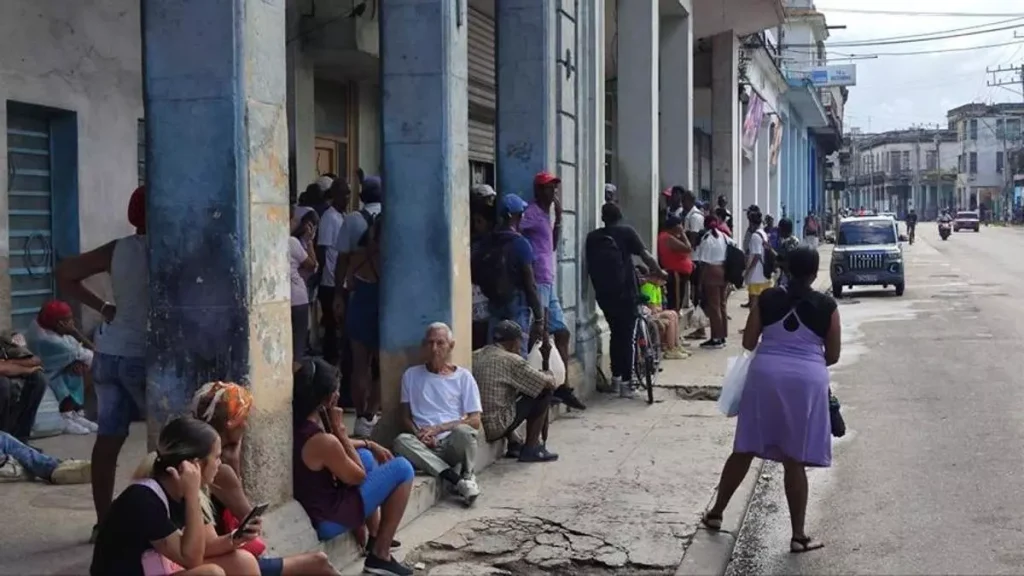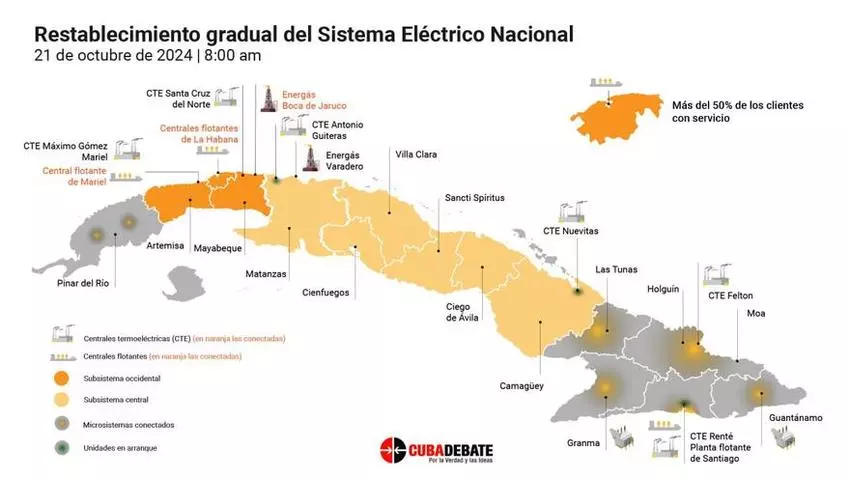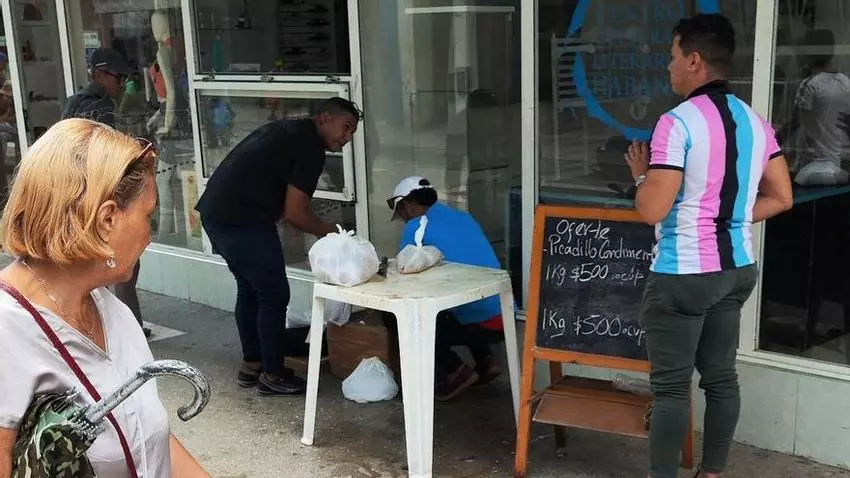The recovery process in the east is much slower and residents fear how Hurricane Oscar might affect that.

![]() 14ymedio, Juan Diego Rodríguez, Havana, 21 October 2024 — “They all wear sweaters under their uniforms in case they’re ordered to out onto the street. This way they can take off their shirts, blend into the crowd and disappear.” Antonio has forbidden his son, who is doing his mandatory military service in Havana, to “beat people up” if his detachment is called upon to suppress street protests. He claims that many parents of other boys in his son’s unit have indicated they have done the same.
14ymedio, Juan Diego Rodríguez, Havana, 21 October 2024 — “They all wear sweaters under their uniforms in case they’re ordered to out onto the street. This way they can take off their shirts, blend into the crowd and disappear.” Antonio has forbidden his son, who is doing his mandatory military service in Havana, to “beat people up” if his detachment is called upon to suppress street protests. He claims that many parents of other boys in his son’s unit have indicated they have done the same.
The man says that the the 19-year-old’s unit is located is “quiet” for now. “There are a lot of wealthy people living in grand houses in the area where they are deployed, all with electric generators and all the comforts,” he says, feeling powerless after another sleepless night.
His wife is more irritated by the general attitude she encounters on the streets. “You go out and everything is normal, as if nothing has happened. Everyone is partying! They’re happy because they’re going to get paid for not working, at least for as long as that this insanity lasts!” she says. “Nobody is bothered. Everyone is playing dominoes and having cookouts, laughing and drinking beer. The ones with the courage to protest don’t get support from their neighbors, who call them shit-eaters.”
Among the scattered slogans that people could be heard shouting, one stood out: “Down with the dictatorship”
However, around 9:00 PM Sunday night, residents in Central Habana banged pots and pans in protest. Among the scattered slogans that people could be heard shouting, one in particular stood out: “Down with the dictatorship!” Despite the sporadic nature of the demonstrations, tensions in Cuba are rising. It is Monday and the country has now been without power for four consecutive days due to a nationwide blackout. Meanwhile, the regime is struggling to restore the power grid by creating electrical “islands.”
The human rights group Justicia 11J reported that there were at least twenty-eight protests on the island between Friday and Sunday night, twenty-one of them in Havana. Other provinces where demonstrations were reported were Holguín, Mayabeque, Santiago de Cuba, Sancti Spíritus, Artemisa and Villa Clara.
Strikingly, one of the protests took place in Manicaragua, a town in Villa Clara which was subjected to the so-called the Escambray cleanup operation. After the revolution, its insurgent population was forced to relocate to Pinar del Río and confined to captive villages, to be replaced by supporters of the regime. The grandchildren and great-grandchildren of those who had been “integrated” confronted police officers on Sunday in front of local government headquarters.
Justicia 11J issued a statement claiming it had received reports of authorities suppressing peaceful protests. It indicated, however, that it has no knowledge of people being detained or forcibly “disappeared” in relation to the events of the last three days. Nevertheless, they added that they cannot rule out the possibility due to an information blackout resulting from “the lack of electricity and internet connectivity.”

Meanwhile, Cubadebate continues to provide updates on the situation in a “breaking news” format that is unusual for state-run media. According to information released a few minutes before 3:00 PM, the Antonio Guiteras thermoelectric plant, whose unexpected shutdown was one of the reasons for Friday’s massive blackout, had “synchronized the microsystem.”
“A large number of units will start coming back online at 3:00 PM because we will be restarting Guitaras, which we will do slowly so as to avoid suddenly overloading the system,” said the minister of Energy and Mines, Vicente de la O Levy, in statements on national television. He did not specify whether the process would take hours or days.
With the power restored for who knows how long, Havana residents took to the streets on Monday hoping to buy food and run errands, which they have not been able to do since Friday. The Boulevard Café, located on the corner of San Rafael and Galiano streets in downtown Havana, was selling fried chicken legs for 50 pesos apiece, though the line to buy them was almost insurmountable.
Similarly, there was a comparable line in front of the ATMs on Toyo Street after four days without power. “There are blocks that have electricity and others that don’t,” said one customer waiting in line. She had just come from the bank on Galiano Street, which was closed because it did not have electricity.

The smell of meat that has gone unrefrigerated for hours is being carried by the wind to places far from its point of sale. Such is the case with the ground meat being sold at the Havana Literary Cultural Center for no less than 500 pesos a kilo.
According to the electric company, more than 88% of Havana’s electricity has been restored. However, a cursory tour of the capital belies that number. The little grocery store on San Rafael Street in Central Havana was open despite having no electricity, with merchandise for sale at astronomical prices. Service on nearby Infanta was not fully restored either. In some other areas, and on Neptuno Street, power did seem to be back on but these were exceptions.
“No electricity, no water and drowning in garbage,” complained an elderly woman as she walked past a a pile of trash on the corner of Neptuno and Campanario streets. On the other hand, the lights in the Luyanó district came back on for about twelve hours. But just as the Guiteras facility was coming back online, they went out again at 3:00 PM.
“All the Energás facilities are ready, all synchronized except one, which allowed us to reboot Havana and the floating power stations in the bay,” said the minister
They were able, he said, “to keep going through the Havana substations all the way to Mariel” and start up a thermoelectric plant there.” This, in turn, “provided start-up power to facilities and floating power stations” so that “the Mariel site and the floating stations could go back online.” There are two floating power stations being leased from Turkey — one in Havana and one in Mariel — as well as another in Santiago de Cuba.
In the east, bringing Unit 5 at the thermoelectric plant in Nevitas back online will help restore power to that region. “Granma [province] is in a better situation because a small generating facility that serves more than 40% of its customers kept running,” he said.
However, he also warned that Hurricane Oscar — even if it does not pass directly over these provinces — could still bring with it winds that impact transmission lines. “The last thing we want is for the system to go down due to a line failure. We are restoring the system much more slowly; customers will not suddenly be brought back online,” he reiterated.
Without offering further details, the foreign minister indicated that Cuba “is in talks to finalize the receipt of this aid”
Though Oscar brought violent rain storms to Baracoa, it caused no significant damage” according to the assessment made by officials and confirmed by Eleazar Moreno Ricardo, networks director at the Cuban Electric Union (UNE). “Conditions are being created to revive the hospital back,” he added. There were, however, minor “impacts” in Maisí and Moa.
As for the rest of the communities in Guantánamo province, they have not been able to carry out damage assessments because it is still raining. To support the recovery of the electrical infrastructure after the storm, five contingents of linemen from Villa Clara, Ciego de Ávila, Camagüey, Granma and Santiago de Cuba are on their way to the eastern province.
What the authorities are not talking about is whether they are expecting fuel shipments. The tanker ship Prairie Tulip is expected to arrive in Moa on Wednesday. It could be transporting fuel from the refinery in Curacao, where Venezuela sends its oil to be processed. In Matanzas, they are still waiting for the oil tanker Ocean Mariner and the coastal vessels Ocean Integrity and María Cristina.
In a Sunday tweet, foreign minister Bruno Rodríguez expressed gratitude for “the efforts and immediate support offered by the governments of Venezuela, Mexico, Colombia, Russia and Barbados to deal with the current situation.” Without offering further details, he indicated that Cuba “is in talks to finalizer receipt of this aid.”
Officials announced there would be a new edition of the TV interview show “Roundtable” on Monday night. It will deal with the recovery process of the country’s electrical grid and the effects caused by Hurricane Oscar in eastern Cuba. The program was last broadcast just four days ago, on Thursday night, and featured an interview with prime minister Manuel Marrero. In that episode he stated, “[I can say] with all objectivity and transparency, we are not yet in a bottomless pit.” He was right. The next day, the entire island went dark.
____________
COLLABORATE WITH OUR WORK: The 14ymedio team is committed to practicing serious journalism that reflects Cuba’s reality in all its depth. Thank you for joining us on this long journey. We invite you to continue supporting us by becoming a member of 14ymedio now. Together we can continue transforming journalism in Cuba.
